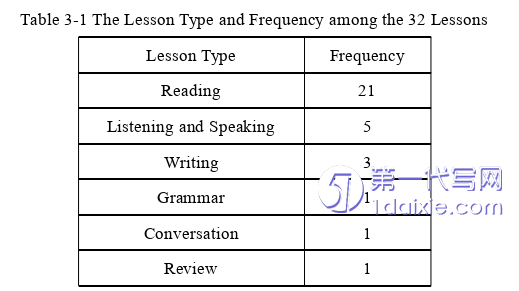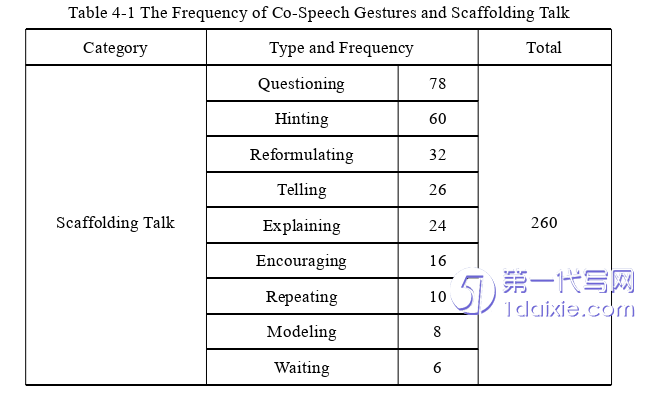本文是一篇英语论文,基于我们在本研究中所讨论的,对英语课堂中的支架效应提出了一些启示如下。首先,提高教师将支架谈话与共语手势结合起来的意识。手势和言语的共现是两种模式的结合,这是多模态的体现。
CHAPTER ONE INTRODUCTION
1.1 Research Background
Co-speech gestures are the hand motions with communicative purpose,whichare produced with speech(Kendon,2004).The research of gestures rose at thebeginning of the last century.With the development of multimedia and informationtechnology,it has become the most concerned and fruitful non-verbal modality.Thestudies of gesture are directly related to many problems in the fields of cognitionscience,language acquisition and discourse analysis.Gesture and discourse are inseparable in meaning and function(McNeil,1992).
Gesture and discourse together form an ideographic system,which enables listeners toget clues from the speaker’s gesture even if they lack background knowledge or donot understand a certain concept,so as to continue communication.Hence,gesturescannot be studied independently of discourse.

Some studies found that teachers significantly used gestures when introducingnew teaching content,explaining abstract concepts,responding to students’questionsas well as evaluating students’performance,which reveals that gesture plays animportant scaffolding function in teaching.Nevertheless,there are few domesticresearches on teachers’co-speech gestures.The domestic researches on the co-speechgestures mainly focus on the theoretical level,such as the studies on the concept,features and metaphor of the co-speech gestures.Similarly,there are few studies onco-speech gestures from the perspective of second language teaching.
1.2 Research Purpose and Significance
The present research is going to explore the micro-level of teachers’co-speechgestures and scaffolding talk,which is expected to have great significance boththeoretically and practically.
In the theoretical perspective,one important theoretical basis of this research isscaffolding theory that stresses learning happens in the teacher-student interactions.Thus the effects of teachers’scaffolding talk and co-speech gestures found in thepresent research would shed some insights into this theory.Besides,their synergisticeffects can not only make the theory of co-speech gestures more diversified,but alsoprovide theoretical support for the use of co-speech gestures and scaffolding means byteachers in real teaching.
With regard to the practical perspective,on the one hand,the research on Englishteachers’co-speech gestures and scaffolding talk in the context of scaffoldingconversations can provide some reference and basis for teachers to use gestures and scaffolding means to support students’learning in language teaching.On the otherhand,it can enhance teachers’awareness of employing scaffolding means andco-speech gestures in teaching,as well as prompt teachers to find the defects in theuse of their co-speech gestures and scaffolding means.According to the relevantstrategies and suggestions finally obtained,it can help teachers to properly useco-speech gestures and scaffolding means in teaching practice,so as to achieve moreexcellent teaching effects.
CHAPTER TWO LITERATURE REVIEW
2.1 Core Concepts
The core concepts in this thesis mainly include co-speech gestures andscaffolding talk.
2.1.1 Co-Speech Gestures
(1)Definition of Co-Speech Gestures
Before giving a definition of“co-speech gesture”,it is essential to illustrate theconcept of“gesture”.Cienki and Muller(2009)define the gesture as“visible,effortfulmovements of parts of the body whose primary purpose is apparently not that ofself-adjustment(for example,as with grooming behavior)or object manipulation(such as lifting a cup to take a drink)”.However,the gesture we will focus on in thethesis is that on the hand instead of other body movements,such as foot gestures,head gestures,and so on,as these body movements have little relevance to messagethat speakers want to convey(Yang,2011a).A typical gesture consists of three majorphases:preparation,stroke,and retraction(Kendon,2004).Then Cienki(2008)adds,“it is the stroke phase which is considered to minimally constitute a gesture”.
Co-speech gestures,also called co-linguistic and co-verbal gestures(Jiang&Wang,2013),refer to“the spontaneous,unwitting,and regular accompaniments ofspeech that we see in our moving fingers,hands,and arms”(McNeill,1994).Andaccording to Kendon(2004),co-speech gestures are the hand motions withcommunicative purpose,which are produced with speech.In addition,co-speechgestures are mostly non-conventional and they may“differ in the degree ofconventionality of their form and their function”(Cienki,2008).
2.2 Previous Studies of Co-Speech Gestures and Scaffolding Talk
2.2.1 Previous Studies of Co-Speech Gestures
(1)Overseas Researches
The overseas researches of co-speech gestures started earlier and has manyresearch achievements.Considering the content and purpose of this research,theauthor mainly elaborate from three aspects:the functions of co-speech gestures,thecoordination between co-speech gestures and discourse features,and the research onteachers’co-speech gestures.
After a century of research and discussion in foreign countries,the functions ofco-speech gestures have been deeply understood.Kendon(2004)believed that gestureand language match each other to construct textual meaning,and gesture cansupplement or emphasize the insufficient expression of accompanying discourse.Jacobs and Garnham(2007)pointed out that co-speech gestures also played a role inpromoting communication.When two people have a face-to-face conversation,thereis a large probability of gesture assistance,and when the listener is attentive,thespeaker is more inclined to use gestures for detailed explanation.Besides,co-speech gestures also have the function of auxiliary explanation or deepening understanding.Other scholars considered that co-speech gestures fulfilled predominantly cognitivefunctions benefiting the speaker him or herself,such as the facilitation of lexicalaccess(Pine et al.,2007)and conceptual planning(Kita&Davies,2009).However,these perspectives are not mutually exclusive(Jacobs&Garnham,2007).Consequently,researchers have focused on exploring these types of functions andtheir underlying mechanisms in greater detail.
CHAPTER THREE RESEARCH DESIGN..................................23
3.1 Research Questions.....................................23
3.2 Research Participants....................................23
3.3 Research Instruments.....................................24
CHAPTER FOUR RESULTS AND DISCUSSION..............................30
4.1 The Holistic Results of Teachers’Co-Speech Gestures and Scaffolding Talk................30
4.1.1 The Frequency of Co-Speech Gestures and Scaffolding Talk..............30
4.1.2 The Success Rate of Scaffolding Conversations...................................31
CHAPTER FIVE CONCLUSION..............................64
5.1 Major Findings........................................64
5.2 Implications for English Teachers in Junior High School..............................66
CHAPTER FOUR RESULTS AND DISCUSSION
4.1 The Holistic Results of Teachers’Co-Speech Gestures and Scaffolding Talk
After watching 32 teaching videos and collecting the data by ELAN,theregained some results:the frequency of co-speech gestures and scaffolding talk in allscaffolding conversations;the success rate of scaffolding conversations,includingtotal scaffolding conversations,the scaffolding conversations when teachers only usescaffolding talk as well as when teachers simultaneously use scaffolding talk andco-speech gestures;the distribution of scaffolding means in five circumstance.
4.1.1 The Frequency of Co-Speech Gestures and Scaffolding Talk
According to the data collected in ELAN,there are nine kinds of scaffolding talkand four kinds of co-speech gestures the teachers use.This result answers the firstresearch question:In the scaffolding conversations in teaching,what co-speechgestures and scaffolding talk are used by teachers in class?The following table showsthe specific data.

CHAPTER FIVE CONCLUSION
5.1 Major Findings
In line with the research questions,this research gains the findings from thefollowing four parts:the teachers’use of scaffolding means and co-speech gestures;the specific scaffolding means and co-speech gestures contribute to the success ofscaffolding conversations;the reasons for the failure of scaffolding conversations;thesynergistic effects of scaffolding talk and co-speech gestures.
First,in terms of the teachers’use of scaffolding means and co-speech gestures,there are three parts including the frequency of scaffolding talk and co-speechgestures,the success rate of scaffolding conversations,as well as the distribution ofscaffolding means.For the part one,there are nine kinds of scaffolding talk and fivekinds of co-speech gestures the teachers use in total.The questioning and deicticgesture are used the most in their respective category.For the part two,there are 186scaffolding conversations in total,including 138 successful scaffolding conversationsand 48 failed scaffolding conversations,in which the success rate is 74%.Furthermore,the success rate of scaffolding conversations achieved only byscaffolding talk is lower than that of scaffolding conversations achieved by both,inwhich the former one is 66%while the latter is 88%.For the part three,when studentsare unable to answer and give an incorrect answer,the scaffolding means of hinting isused the most;when students give an incomplete answer,questioning ranks the first;when students give a vague answer,reformulating is used more than any otherscaffolding means;when students have difficulty in language organization,teachersare more likely to use telling and hinting.
reference(omitted)
